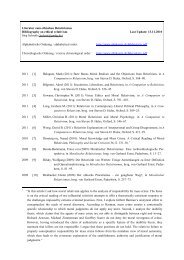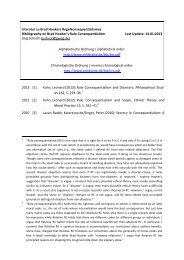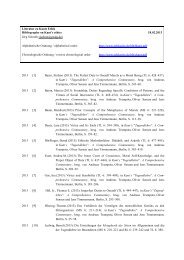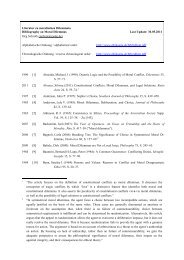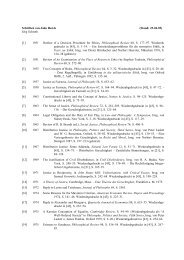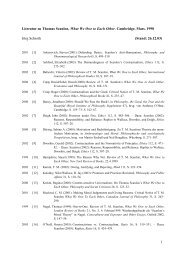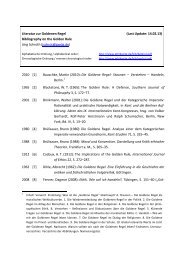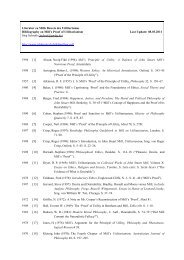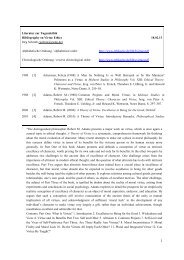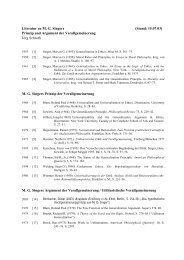Literatur zu Kants Ethik - Ethikseite
Literatur zu Kants Ethik - Ethikseite
Literatur zu Kants Ethik - Ethikseite
Create successful ePaper yourself
Turn your PDF publications into a flip-book with our unique Google optimized e-Paper software.
2010 [364] Gressis, Rob (2010): Recent Work on Kantian Maxims II, Philosophy Compass 5, S. 228–39. 48<br />
2002 [365] Grimm, Stephen R. (2002): Kant’s Argument for Radical Evil, European Journal of<br />
Philosophy 10, S. 160–77.<br />
2000 [366] Grondin, Jean (2000): Zur Phänomenologie des moralischen ‚Gesetzes’. Das kontemplative<br />
Motiv der Erhebung in <strong>Kants</strong> praktischer Metaphysik, Kant-Studien 91, S. 385–94.<br />
1988 [367] Grünewald, Bernward (1988): Praktische Vernunft und transzendentale Einheit. Das Problem<br />
einer transzendentalen Deduktion des Sittengesetzes, in Kant. Analysen – Probleme –<br />
Kritik, hrsg. von Hariolf Oberer und Gerhard Seel, Würzburg, S. 127–67.<br />
1993 [368] Grünewald, Bernward (1993): Zur moralphilosophischen Funktion des Prinzips vom höchsten<br />
Gut, in Naturzweckmäßigkeit und ästhetische Kultur. Studien <strong>zu</strong> <strong>Kants</strong> Kritik der<br />
Urteilskraft, hrsg. von Karl-Heinz Schwabe und Martina Thom, St. Augustin, S. 133–<br />
39.<br />
2004 [369] Grünewald, Bernward (2004): Form und Materie der reinen praktischen Vernunft. Über die<br />
Haltlosigkeit von Formalismus- und Solipsismus-Vorwürfen und das Verhältnis des<br />
Kant took maxims to be what ordinary people of today take them to be, namely pithily expressed precepts of<br />
morality or prudence. Next comes the position, most associated with Rüdiger Bittner and Otfried Höffe, that<br />
maxims are Lebensregeln, or ‘life-rules’ – quite general rules for how to conduct oneself based on equally<br />
general outlooks on how the world is. These first two interpretations make sense of Kant’s claim, made in<br />
his anthropological and pedagogical writings, that we have to learn how to act on maxims, but they become<br />
less plausible in light of Kant's probable view that people always act on maxims – after all, how can people<br />
learn how to act on something they always act on anyway? The next two views, each advanced, at different<br />
times, by Onora O’Neill, make better sense of the fact that people always act on maxims, for they hold that<br />
maxims are intentions – either specific intentions, such as ‘to open the door’, or general intentions, such as<br />
‘to make guests feel welcome’– and it is perfectly sensible to claim that people always act on intentions.<br />
However, they face the same problem as the two previous views, which is that if people always act on<br />
maxims, what sense does it make to say they also have to learn how to act on them? Henry Allison, the<br />
main representative of the fifth view, claims, on the basis of Kant's doctrine of the ‘highest maxim’, that<br />
maxims are principles organized hierarchically, such that an agent endorses one maxim because she<br />
endorses a more general maxim. Unfortunately for Allison, there is little direct textual support for his claim<br />
that maxims are organized hierarchically.”<br />
48 “Maxims play a crucial role in Kant’s ethical philosophy, but there is significant disagreement about what<br />
maxims are. In this two-part essay, I survey eight different views of Kantian maxims, presenting their<br />
strengths and their weaknesses. In Part II: New Approaches, I look at three more recent views in somewhat<br />
greater detail than I do the five treatments canvassed in ‘Recent Works on Kantian Maxims I: Established<br />
Approaches’. First, there is Richard McCarty’s Interpretation, which holds that Kant’s understanding of<br />
maxims can be illuminated by placing them in the context of the Wollfian tradition, according to which<br />
maxims are the major premises of practical syllogisms. The next subject Maria Schwartz, holds that careful<br />
attention to Kant’s distinction between rules and maxims, as well as Kant’s concept of happiness, allows us<br />
to make sense of almost all of Kant’s remarks on maxims. It may be, however, that on Schwartz’s view<br />
agents turn out to perform actions as opposed to thoughtlessly habitual behaviors much less often than is<br />
plausible. This leads to the final approach, exemplified by Jens Timmermann, which is that Kant<br />
understands maxims equivocally. I claim that something like Timmermann’s approach is the only way to<br />
make sense of all of what Kant has to say on maxims.”



